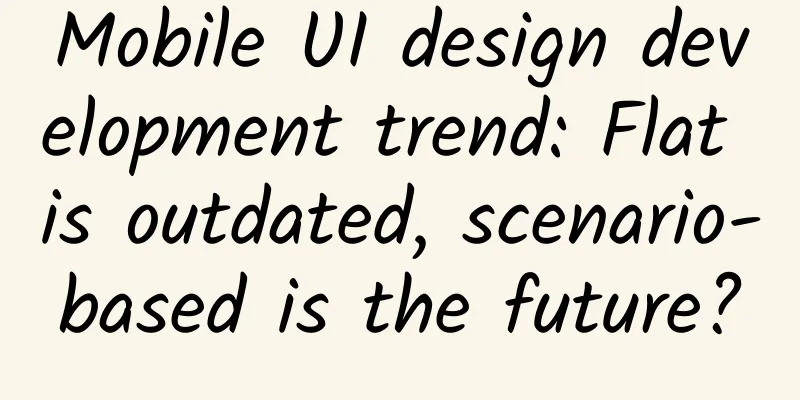Mobile UI design development trend: Flat is outdated, scenario-based is the future?

|
In fact, most of the design elements we see in daily life come from printed publications and aesthetic pioneers. It may be difficult to trace the origin of flat design. In the history of UI design development, skeuomorphism and flatness often conflict with each other. Time will tell which is better. For now, UI design seems to be moving towards a flat style, which seems to indicate the development of informatization. Flatness In the digital field, Metro Design is the most classic case in the field of graphic design. It is an interface style designed by Microsoft based on design language. It was first used in Microsoft's Zune player, and later in Microsoft's Windows Phone 7. Later, Windows 8 also used this design to adapt to tablet touch devices. Metro, as a typography-based design, pays more attention to fonts than other UI design styles. Microsoft Metro Design Speaking of Google's material design, there are many Chinese translations, such as "material design", "material design", etc., but the most accurate one should be "texture design". Currently, this design language provides a more consistent and wider "look and feel" on mobile phones, tablets, desktops and "other platforms". It can make colors more vivid and animation effects more prominent. Google's idea is to let developers on the Google platform master this new framework so that all applications have a unified appearance and users can get a coherent experience. Material design Since Apple released iPhone 5s and iOS 7, the flat style of Apple's system has been introduced. This design was inspired by the late legendary German designer Otl Aicher. iOS 7, led by Jonathan Ive, completely abandoned three-dimensional, realistic, and detailed, and replaced them with flat, simple lines, and bright color blocks. However, in Apple's design, shadows, gradients, highlights, and even textures are still there, so Apple's "flatness" is not really "flatness". Apple's flat design and skeuomorphism The so-called skeuomorphism must be an object that already exists in the real world and is often used in people's daily lives. The things that people have used in their lives are more or less simulating similar things that appear in the real world. This is "skeuomorphism". The original intention of this skeuomorphism design is to make people better and more vividly understand the functions that the system wants to express. It will spend extra effort to depict UI details and decorations. This type of design is not only reflected in the skeuomorphism of icons, but can also be expressed in dynamic processes. The essence of skeuomorphism in UI design is to help users understand the function of an application or a button. The application of skeuomorphism in the digital world can be traced back to the 1980s. Although it was not invented by Apple, it was Apple’s first commercial user GUI in 1984 that gave everyone a good interpretation of the desktop and icons with skeuomorphism features - they are very similar to folders and papers in the real world. This design concept has been used to this day and has become the mainstream design in the digital world. The skeuomorphic style has pushed skeuomorphism to a very high level in the versions before iOS6. Every texture, shadow, texture, and every detail in the visual world has been carefully crafted and can be called perfect. At this time, it is very difficult to surpass it, especially to surpass it in the way of skeuomorphism. Moreover, the things in people's lives are very limited, and the daily objects we are familiar with are constantly being replaced. It is difficult to find objects in real life to simulate the functional innovation of applications. The skeuomorphic style will limit the development of innovative applications. The transition from skeuomorphism to flatness In the era when feature phones were popular, the skeuomorphic style was very popular. Because a feature phone does not have as many functions and software expandability as the current smart phones, feature phones usually only need common functions such as cameras, compasses, clocks, radios, recorders, etc., plus the necessary functions of making calls and sending text messages, so skeuomorphism can be easily accepted by everyone, including the early iOS system Icon design, which is also a skeuomorphic design. This design has continued until iOS 6 reached a peak. iOS 6 Skeuomorphism Skeuomorphism was very popular among the elderly and children in the era of feature phones, and they could use it without any learning. With the popularity of smart phones and digital devices, a universal mobile phone has gained more and more people's favor, becoming the starting point for the decline of skeuomorphism. At the 2013 WWDC conference, Apple released iOS 7, an operating system based on a flat style design. The new design removed the previous skeuomorphic textures and textures, and integrated the delicate dynamic effects and functional diagrams to make the interface simpler. Another factor that cannot be ignored in iOS7 flattening is aesthetic fatigue. In the era of feature phones, GUI design was a universally recognized design aesthetic. Popular products on the web usually have similar design aesthetics, such as three-dimensional, inner shadow, outer shadow, etc. For designers, they will be proud of implementing such an interface. However, design usually becomes complex after being simple for a long time, and simple after being complex for a long time. Both the producer and the user will get aesthetic fatigue. Even if they are not tired, some products need to be innovative and different. Skeuomorphism In the end, with the changes of the times, the design attributes of skeuomorphism are becoming less and less, and it has gradually become a visual decorative style. As a design, the benefits of skeuomorphism will become less and less, and the problems brought about by the increase in development costs and aesthetic fatigue make it less and less reason to use it. However, skeuomorphism has not disappeared. On the one hand, there is no good or bad style, and there will always be some people who like it. On the other hand, individual programs need fun and affinity, and it is indeed necessary to use skeuomorphism. The future-scenario-based "Scenarios" are everywhere, and there are specific scene relationships between specific times, places and people. With the increasing competition among Internet platforms, the phenomenon of product homogeneity is becoming more and more serious. The current situation of the industry with increasingly stalemate competition has prompted some platforms to start to make efforts in the direction of scenario-based and seek new breakthroughs. With the continuous improvement of various models, more and more scenes based on clothing, food, housing and transportation have been created. This "scenario-based" trend has also become the future development direction. In the future of scenario-based, truly scenario-based products must be able to actively sense the arrival of scenarios and integrate time fragments. For example, there are many sports apps that can record pace, distance and other information based on GPS and sensors to help users plan their sports reasonably. However, most of the current software requires users to manually start the app first. Some time ago, a company in the United States developed a new generation of running apps based on the concept of "scenario perception" that can sense the scene and perform corresponding operations. Summary Of course, for now, the flat minimalist style still caters to everyone's aesthetics and is difficult to be replaced. However, the same reason still applies. With the development of the times, the advancement of technology, and people's aesthetic fatigue, the flat style will inevitably adjust its direction or even be replaced by other designs in the future. The design style is closely related to the technology of its era, and the general trend is still simplification. For example, the 3D holographic UI concept proposed in recent years, the 3D interface is closer to reality than the 2D interface, and can better complete the interaction. 3D holographic projection is a trend in any field, from complex to simple. UI design is just a form of expression, and more important is the human-computer interaction behind it. It must be said that a good product must be able to push the right information to the users at the right time and the right place. Scenario-based design seems too good to be true now, but I believe in the development of technology. Once scenario-based design is realized in the future, human-computer interaction will become very simple. As a winner of Toutiao's Qingyun Plan and Baijiahao's Bai+ Plan, the 2019 Baidu Digital Author of the Year, the Baijiahao's Most Popular Author in the Technology Field, the 2019 Sogou Technology and Culture Author, and the 2021 Baijiahao Quarterly Influential Creator, he has won many awards, including the 2013 Sohu Best Industry Media Person, the 2015 China New Media Entrepreneurship Competition Beijing Third Place, the 2015 Guangmang Experience Award, the 2015 China New Media Entrepreneurship Competition Finals Third Place, and the 2018 Baidu Dynamic Annual Powerful Celebrity. |
<<: Most popular iPhone selection: iPhone 7 only ranked sixth
Recommend
How to place advertisements for novice APP operators
What is operation ? This kind of question appears...
How to promote and attract traffic to Xianyu? The practical method of attracting traffic to Xianyu with coupons is revealed!
Xianyu is now a traffic-generating platform that ...
Cataracts are not exclusive to the elderly, people of all ages should be careful!
When it comes to cataracts, many people have the ...
Fire protection maintenance technical service mini program function, how much does it cost to develop a WeChat fire protection mini program?
Fire safety is more important than anything else. ...
Why are all the ads I see on TikTok games?
Capture SSS-level Lingkun at the beginning, 5th t...
Operation and promotion: How to get 100,000 users with 1 cent? Is this true?
How to get 100,000 users with 1 cent? This is pro...
Is human the most dangerous animal in the world? Check out the correct answer
Figure 1: The deadliest animals. Ranked by estima...
The flood situation in Guilin and Meizhou is worrying. After the heavy rain, you must pay attention to these!
Recently, many places in Fujian, Guangdong and Gu...
“Gold-plated” food was fined 100,000 yuan. Will accidentally eating gold foil harm your body?
Key Points ★ Currently in our country, adding gol...
Lard residue is not really that bad.
When it comes to mouth-watering childhood memorie...
How can online education create a training camp with high conversion rates?
1. Introduction After several years of developmen...
Norovirus is entering its peak period! How to prevent it?
China Science and Technology News Network, Februa...
Technology Morning News | Shanghai adds 3 medium-risk areas
【Today’s cover】 Golden rays of light pierce throu...
How to build a complete growth model?
Today we will talk about three aspects: what is a...









